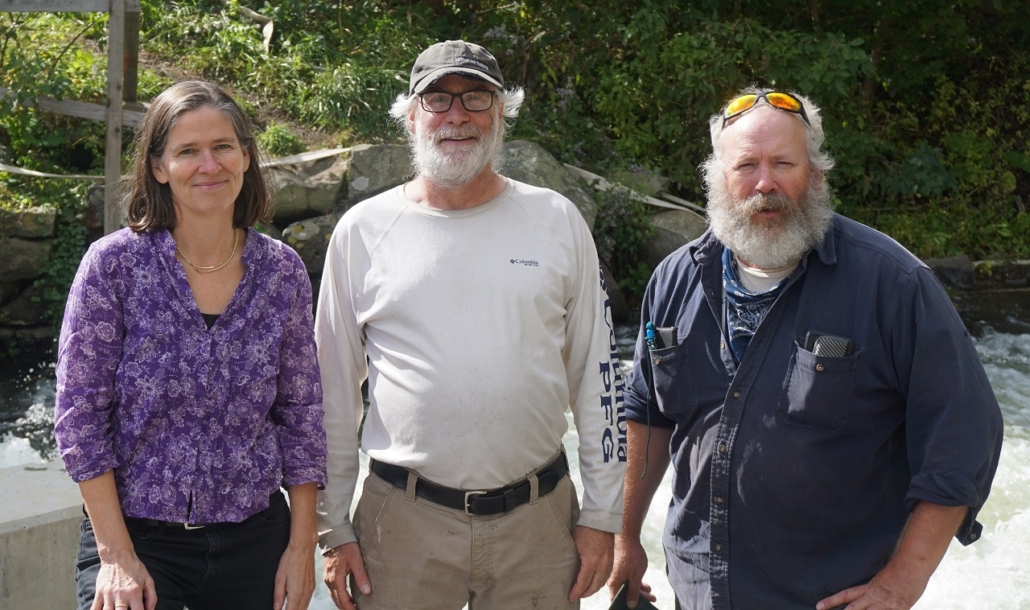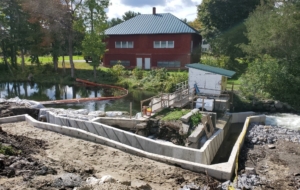These fish have been waiting 200 years for this moment

The Maine Rivers team at the location of the new fishway constructed at the head of Outlet Stream, from left to right, Landis Hudson, executive director; Matt Streeter, project manager; and Nate Gray of the Maine Department of Marine Resources. (photo by Eric W. Austin)
by Eric W. Austin
It’s been more than 200 years since an alewife has successfully made its way, under its own power, from the ocean and up the Sebasticook River to Outlet Stream before arriving at China Lake, but all that’s about to change. After nearly seven years of hard work, oceans of red tape, scores of harrowing town meetings, contentious public debate and skeptical property owners, the Maine Rivers team has succeeded in their efforts to bring a fish back to China Lake.
To understand the momentous nature of their success, we must travel back in time to examine the problem they were attempting to address when they first conceived of this project back in 2014.
As European settlers moved up the New England coast and into Maine’s interior in the 1700s, they naturally established communities along the state’s abundant water sources. Beyond their use as fresh water for crops and consumption, fast-moving rivers and streams provided a source of power for the growing lumber and agricultural industries. As a result, dams popped up everywhere. In Vassalboro alone, there were six dams along Outlet Stream, the egress for most of the water in China Lake.
These dams provided an important resource for growing settlements in central Maine, but they also had one major negative effect on the environment: by blocking the flow of water the dams also prevented fish from traveling between the lake and the ocean as they had been doing for thousands of years. Now, two centuries later, these dams no longer offer the benefits they once did, but they have continued to block the movement of migratory fish up and down our waterways. This has had an ecological impact on the food web in the lake and all the way along Outlet Stream to Sebasticook River and beyond.
Maine Rivers, a nonprofit group initially founded by the Natural Resources Council of Maine before becoming an independent organization in 2003, with a mission to “protect, restore and enhance the health and vitality of Maine’s rivers,” has been working with many local groups, including the towns of China and Vassalboro, the Maine Department of Marine Resources, the Kennebec Water District, the Sebasticook Regional Land Trust and the China Region Lakes Alliance, to remove these legacy dams – or build fishways around them – and free up the Outlet Stream for the return of migratory fish like river herring (alewives and blueback herring), sea lamprey and salmon, among others.
The core Maine Rivers’ team consists of executive director Landis Hudson, project manager Matt Streeter, and longtime resident of Vassalboro and Maine Department of Marine Resources’ employee, Nate Gray. I have had the pleasure of meeting with them twice before, in 2019 and 2020, to discuss their progress on this project.
“The fact that the one and only Nate Gray, who works for the Department of Marine Resources, lives in Vassalboro,” Hudson says about one of the reasons for their success. “You cannot find a person with any more expertise, connections and commitment. He’s been a leading light. Vassalboro is lucky to have him. The State of Maine is lucky to have him, and I think it’s fair to say that it’s hard to imagine a project of this scale being done anywhere else in New England.”
Over the course of the project, three dams have been dismantled, Lombard, Masse and — this year — Morneau, and three fishways have been constructed, at Box Mill and Ladd dams, and most recently, at the head of Outlet Stream.
Although Maine’s Department of Marine Resources has been stocking alewives in China Lake since the late ‘90s, the fish could not return to the lake for spawning because of blockages created by these dams along Outlet Stream and must be restocked every year. Nate Gray says he expects the lake can support about one million alewives, although that will fluctuate from year to year.
Alewives play an important role in the ecology of the lake and in the food web all along the water sources leading away from it. Their young feed on the phosphorous-rich plankton in the lake, and carry those nutrients with them back to the ocean where most are eaten by bigger fish. In this way, they serve an important role in maintaining an appropriate nutrient balance in the lake and their return should help increase water clarity over time.
One aspect of the project that doesn’t get enough attention is the work the team does after a dam is dismantled. From the head of Outlet Stream, where the team is finishing the final fishway, we traveled just up the road to the remains of Masse Dam to see how the landscape has changed over the years since it was removed.
A dam stops the flow of water and creates a pond behind it. When it is removed and the stream is allowed to proceed naturally, the pond drains and what is left is a broad, muddy patch of ground devoid of any vegetation. An important part of the Maine Rivers project has been to restore the ecology of these areas and nurture the healthy return of the original habitat. They have worked with the local Vassalboro schools, particularly the fifth and sixth graders, to plant native shrubs, trees and flowers that would have grown here before the dams were constructed.
“The more diverse the habitat, the more diverse the plants are, the greater the habitat value for insects and birds, rodents and everything else,” says project manager Matt Streeter, gesturing across the field that used to be the location of a pond behind Masse Dam.

The new fishway recently constructed at the head of Outlet Stream in Vassalboro. (photo by Nate Gray)
The Outlet Stream will also run cooler as a result of the dam removals, since standing water like the pools created behind the dams tend to heat up and carry that heat downstream. This cooler water should attract new species of fish that appreciate the colder temperatures, such as brook and brown trout. Eagles are already flocking to the newly opened waterway, which is a good sign.
And, of course, there are the alewives. Since the Department of Marine Resources have been stocking alewives in China Lake for years, they are already imprinted with the location of the lake and will return for spawning. This spring will see thousands of the fish fighting their way up the fishways in their efforts to start a new generation. (The best places to watch the alewife runs will be at either Ladd or Box Mill dams, as the fishway just finished at the head of Outlet Stream is not set up for public viewing.)
Executive director of Maine Rivers, Landis Hudson, says the expertise they have built in the team over the years of working on the project is their greatest asset. And their work is not done. “There are lots of opportunities in Maine for improving fish passage,” she says.
“There are thousands of dams around the state that are doing nothing useful,” confirms project manager Streeter.
So, let’s pause and appreciate the simple alewife. After more than 200 years, this is the moment they’ve been waiting for.
Responsible journalism is hard work!
It is also expensive!
If you enjoy reading The Town Line and the good news we bring you each week, would you consider a donation to help us continue the work we’re doing?
The Town Line is a 501(c)(3) nonprofit private foundation, and all donations are tax deductible under the Internal Revenue Service code.
To help, please visit our online donation page or mail a check payable to The Town Line, PO Box 89, South China, ME 04358. Your contribution is appreciated!




Leave a Reply
Want to join the discussion?Feel free to contribute!